Dungarvan Golf Club is situated in one of the most picturesque areas in Ireland’s south east. It is located just outside the town of Dungarvan, County Waterford and is adjacent to Dungarvan Bay, the Waterford Greenway and set against the backdrop of the Comeragh mountains.
History
The club was founded in 1924 at a place called Cunnigar. Cunnigar is a 3km long sand spit known as the Conniger Peninsula. However, the club only resided there for 5 years. Coastal erosion and Cunnigar inaccessibility led the club to seek an alternative venue. This was a pity as it would have made for an ideal location for a golf links but there was never enough land on the peninsula for this to happen. The club moved to two other locations before settling, in 1993, to its present location at Knocknagranagh. The success of Dungarvan Golf Club and the growing population in Dungarvan town led to calls from the members to expand to eighteen holes. When the various options regarding expansion and ‘moving house’ were considered during the late 1980s the club decided to purchase some farm land nearer to the town and develop today’s challenging course.
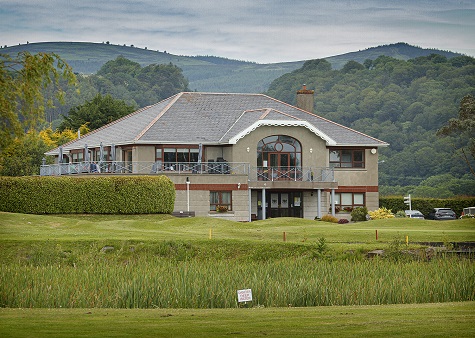
The clubhouse at Dungarvan as you would see it coming down the 18th fairway with the Comeragh mountains in the background
In the early years Dungarvan Golf Club was a nine hole facility but the move to Knocknagranagh allowed the opportunity of the club to become a top quality eighteen hole championship course. The course was designed by local man, the late Maurice Fives. Ironically, the place it moved from in 1993 is now the location of it’s friendly rival club The Gold Coast Golf Club.
The greenkeeping staff
The course manager at Dungarvan is Anthony Morrissey. I met with Anthony, along with the chairman of the course committee, John Moloney. They both brought me around the course on a lovely June morning. However, the pressure was on as Anthony was preparing the course for the Captains prize, which was taking place on the upcoming weekend. Despite this I was generously given time to be brought around to see the course. “If you had come when the tide was full you would have been able to take nicer photographs”, said John. As it happened, it didn’t matter what way the tide was, as Anthony and his staff had the course in great condition.
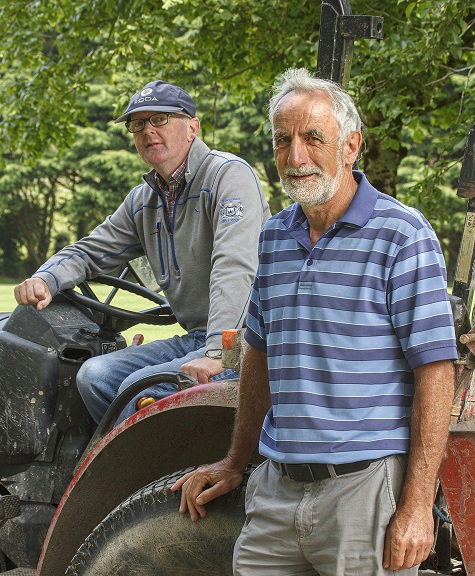
Anthony Morissey (left) with John Moloney, chairman of the course committee
John has a Degree in Agricultural Science from University College Dublin (UCD) but is now retired from Teagasc (the state agency that provides research, advisory and education in agriculture and horticulture, in Ireland). John has acquired a lot of knowledge and experience of the land during his career, particularly when it comes to drainage and soil physiology so he has a lot to give to the club.
Anthony Morrissey first worked at Dungarvan during the building of the 18 hole course in 1992. He left shortly afterwards but returned in 1994 and has been here ever since. In September 2008 he got the top job of Course Manager after succeeding Michael Mernin, who had retired. 2008 was a tough year to take over the reigns of maintaining the course, as it was then that the financial crash occurred. Ireland, in particular, was one of the countries that was hit the hardest as most of the economy revolved around the construction and property sector. As a result, club memberships in Irish golf clubs, including Dungarvan, dropped significantly. Dungarvan is now beginning to get its membership numbers back to what it was pre 2008.
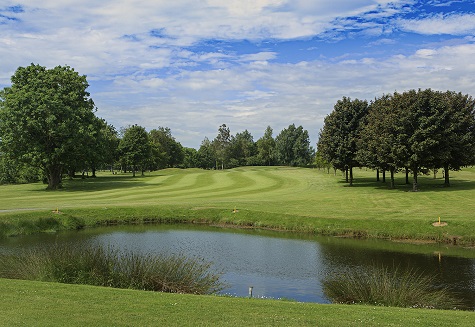
A view of the 11th hole
The course is situated on heavy soil. About 12 - 18 inches below the surface lies a 30 inch layer of heavy marl known as gley. This causes a lot of wet areas around the course as surface water is slow to soak away. To compound the problem there is also a high water table. To tackle this problem many drains have been installed. There are plans, this year, to carry out drainage work on the 4th, 7th and 9th holes. Only last October a 5ft piped drain was cut across the 15th and 14th fairways to divert the water coming up from the water table below. The drain outlet goes into the estuary, which is beside the 14th fairway. Having the estuary traversing some of the course is useful as it provides outlets for drains coming from the course. A Homburg drainjetter has been hired to clean out existing drains on the course. This machine will pump water into the drains at such a high force that any material blocking the drains will be flushed out.
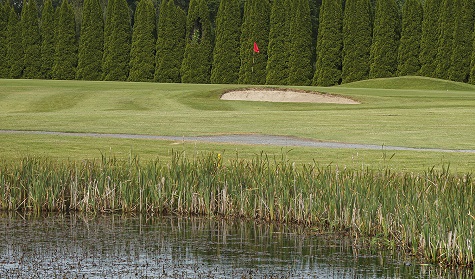
A line of conifers forms an unusual backdrop to the 8th green
During the last lockdown the course was closed for play from December 2020 to April 2021. During that time Anthony took advantage of the empty course by thinning out some of the trees that were planted when the course was built. He was also able to build some pathways for the course machinery and golf buggies.
Course maintenance
The greens in Dungarvan are sand based, built on USGA specifications back in 1992. In 2008 there were five greenkeeping staff maintaining the course. This has since been reduced to three, with one seasonal worker taken on during the summer. Bernard Crotty is one member of staff who has worked with Anthoney for twenty years. He has gathered a lot of experience over those years and is a valuable asset to the team, as too is Daniel O’Keeffe, Anthony’s other full time staff member. Even though Daniel is younger, he worked in Cork Golf Club before joining the Dungarvan greenkeeping staff two years ago.
With only three full time staff, the pandemic lockdowns were challenging times for them. It is remarkable to think that these three men can maintain the 120 acre course to such a high standard. “It would be great to return to five full time greenkeepers again. Hopefully, some day this will happen”, said Anthony. To make up for the shortfall in staff, some volunteers come in for 3 – 4 hours each week, usually on a Wednesday morning, to help with course work such as raking and edging bunkers, hedge cutting, repairing divots and marking out of bound areas. Even some lady members help out by volunteering to maintain the flower beds around the clubhouse.

The greenkeeping staff from left: Bernard Crotty, Anthoney Morrissey, Daniel O’Keeffe. Missing from the photo is Nioclás O’Condúin
The greens are mown at 3mm in summer, increasing to 5mm in winter. Tees and aprons are cut at 12mm while the fairways are mown at 14mm. The club recently purchased a Jacobsen HR500 rough mower, replacing their trailing five-gang mower. This new mower gives a better quality of cut, especially in wet conditions. The average club member is in the high age profile so to make it easier for them to get around and speed up play the rough is kept reasonably short at 44mm (1¾ inches).
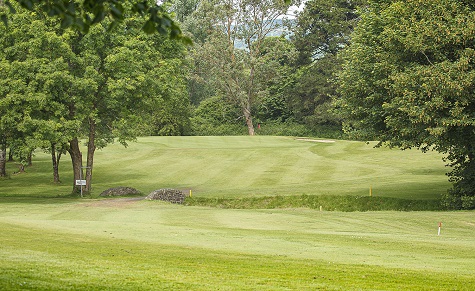
The beautiful 2nd hole
Anthony seldom uses granular fertilisers on the greens. It is mostly liquid feed that is given each month, usually 28:0:0 (N-Sure) with 3:7:18 and Primo Max added in the mix. These are replaced with Turfite during the winter months. Tee boxes are fed with 16:16:16 granular fertiliser throughout the year. The green surrounds are given an application of Multigreen 25:3:18 once a year.

A mature ash tree forms a canopy over the 13th tee with Dungarvan estuary and the old railway bridge, which now forms part of the Greenway cycle path in the background
The agronomist at Dungarvan is Conor Nolan from the STRI. Conor recommends a feeding and maintenance programme for the greens every season. The emphasis is on keeping the greens as healthy as possible, thus reducing the need to apply fungicides. Phosphites are applied to the greens to encourage a healthy sward. Being vigilant to disease infection is key and as soon as the early signs of infection are spotted, fungicides are given. Because of the amount of fungicides that have been removed from the market, there is less choice of products. However, from those that are available, Anthony chooses a systemic fungicide such as Instrata Elite, Medallion or Heritage. The greens are verti drained around 5 – 6 times each year.
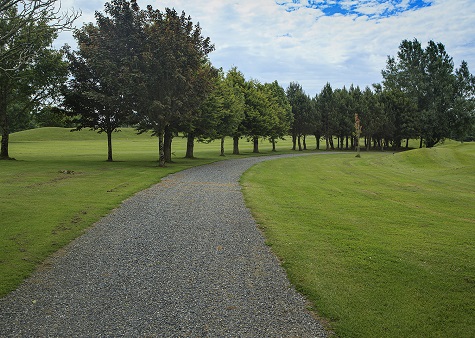
One of the pathways installed during last winter
Sand topdressing is applied each week to the greens. The greens have not been hollow cored since 2017. Building up a high sand level has reduced the amount of thatch forming. Around 80 tons of sand per hectare is applied to the tees. Anthony would like to increase this to 120 tons. Wet areas on fairways are also given a sand topdressing.

Daniel O’Keeffe mows one of the tee boxes
There is a lot of wildlife around the course with mallard ducks being a common sight. If you are patient enough you may spot some buzzards, foxes, rabbits and even a mink.
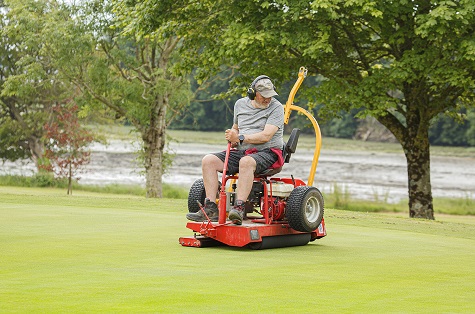
Bernard Crotty on the turf iron as he rolls one of the greens
With the Comeragh Mountains at one end and Dungarvan Bay at the other, Dungarvan Golf Club certainly provides a beautiful location to play a round of golf. Add a well maintained course to this and you cannot but enjoy a great experience at Dungarvan, no matter what way the tide is.